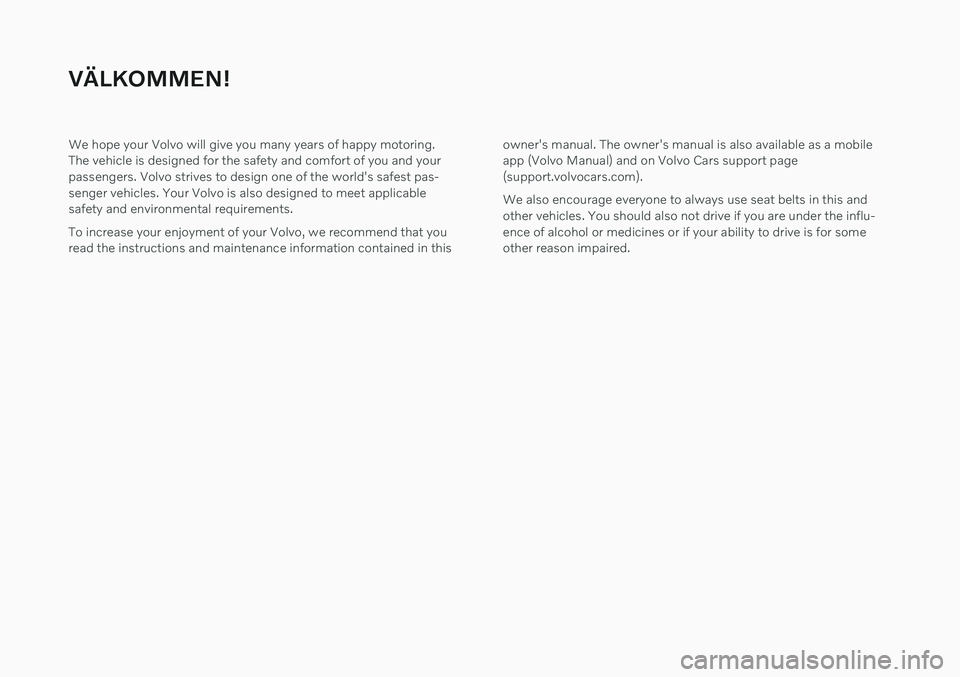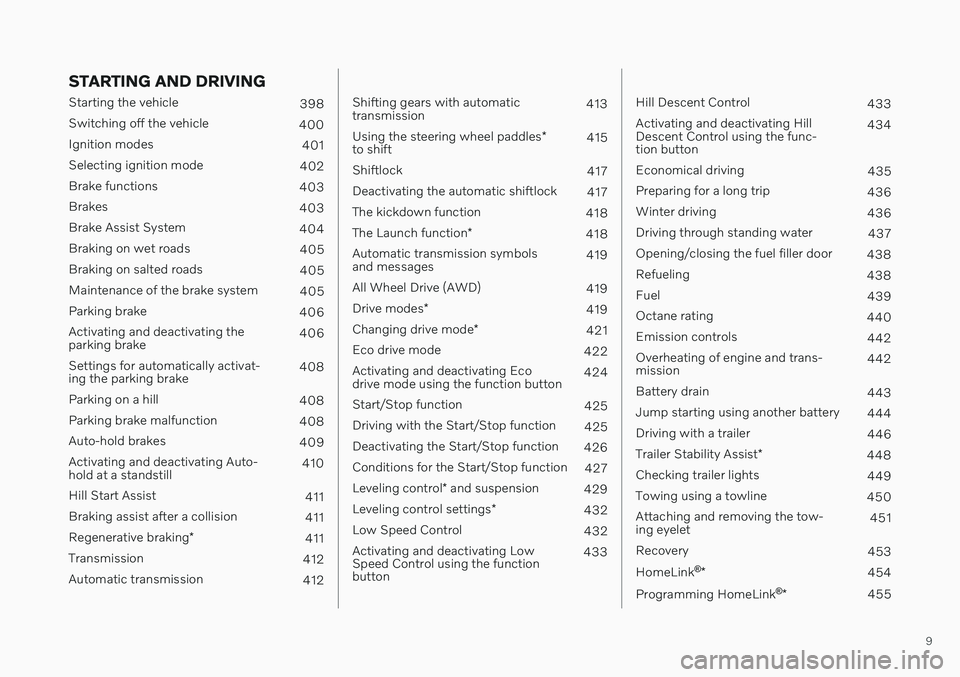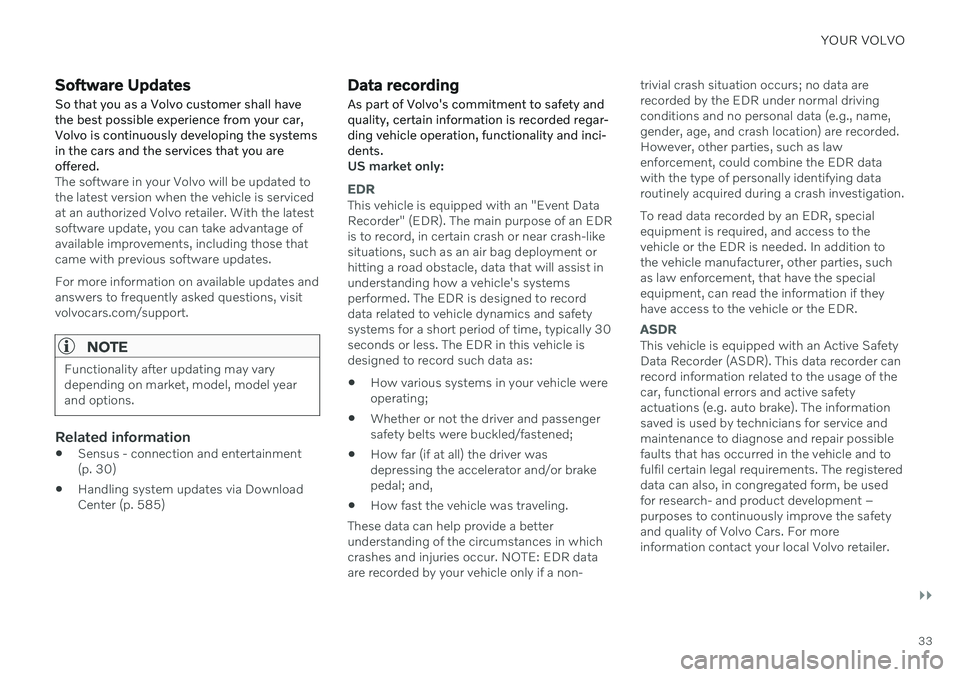2021 VOLVO V90 CROSS COUNTRY maintenance
[x] Cancel search: maintenancePage 3 of 683

VÄLKOMMEN!
We hope your Volvo will give you many years of happy motoring. The vehicle is designed for the safety and comfort of you and yourpassengers. Volvo strives to design one of the world's safest pas-senger vehicles. Your Volvo is also designed to meet applicablesafety and environmental requirements. To increase your enjoyment of your Volvo, we recommend that you read the instructions and maintenance information contained in thisowner's manual. The owner's manual is also available as a mobileapp (Volvo Manual) and on Volvo Cars support page(support.volvocars.com). We also encourage everyone to always use seat belts in this and other vehicles. You should also not drive if you are under the influ-ence of alcohol or medicines or if your ability to drive is for someother reason impaired.
Page 10 of 683

8
Detecting obstacles with City Safety335
City Safety in crossing traffic 337
Limitations of City Safety in cross- ing traffic 338
City Safety steering assistance forevasive maneuver 338
City Safety steering assistancelimitations during evasive maneuvers 339
Automatic braking during delayedevasive maneuvers with City Safety 339
City Safety braking for oncomingvehicles 340
City Safety limitations 341
City Safety messages 344
Steering assistance at risk of collision 345
Activating or deactivating steeringassistance during collision risks 346
Run-Off Mitigation with steeringassistance 346
Steering assistance during colli-sion risks from oncoming traffic 347
Steering assistance during colli- sion risks from behind *348
Steering assistance during colli- sion risks limitations 349
Symbols and messages for steer-ing assistance during collision risks 350
Rear Collision Warning *
351
Rear Collision Warning * limitations
351
BLIS *
352
Activating or deactivating BLIS 353
BLIS limitations 354
BLIS messages 355
Driver Alert Control 356
Activating or deactivating Driver Alert Control 357
Selecting guidance to a rest area ifthe Driver Alert Control warninghas been given 357
Driver Alert Control limitations 358
Distance Alert *
358
Activating or deactivating Dis-tance Alert 359
Distance Alert limitations 359
Cross Traffic Alert *
360
Activating or deactivating Cross Traffic Alert * 361
Cross Traffic Alert * limitations
361
Cross Traffic Alert * messages
363
Park Assist *
364
Park Assist front, rear and sides *
365
Activating or deactivating Park Assist *
366
Park Assist limitations 367
Park Assist symbols and messages 368
Park Assist Camera*
369
Location and field of vision of Park Assist Cameras * 370
Park Assist Camera trajectory lines *
372
Park Assist sensor field 374
Activating Park Assist Camera 375
Park Assist Camera symbols and messages 377
Park Assist Pilot *
379
Types of parking with Park Assist Pilot * 380
Using Park Assist Pilot *
381
Leaving a parallel parking spacewith Park Assist Pilot *384
Park Assist Pilot * limitations
384
Park Assist Pilot * messages
386
Radar sensor 387
Radar sensor type approval 388
Camera 390
Camera/radar sensor limitations 390
Recommended camera and radar sensor maintenance 393
Camera and radar unit symbolsand messages 395
Page 11 of 683

9
STARTING AND DRIVING
Starting the vehicle398
Switching off the vehicle 400
Ignition modes 401
Selecting ignition mode 402
Brake functions 403
Brakes 403
Brake Assist System 404
Braking on wet roads 405
Braking on salted roads 405
Maintenance of the brake system 405
Parking brake 406
Activating and deactivating the parking brake 406
Settings for automatically activat-ing the parking brake 408
Parking on a hill 408
Parking brake malfunction 408
Auto-hold brakes 409
Activating and deactivating Auto-hold at a standstill 410
Hill Start Assist 411
Braking assist after a collision 411
Regenerative braking *
411
Transmission 412
Automatic transmission 412
Shifting gears with automatic transmission413
Using the steering wheel paddles *
to shift 415
Shiftlock 417
Deactivating the automatic shiftlock 417
The kickdown function 418
The Launch function *
418
Automatic transmission symbolsand messages 419
All Wheel Drive (AWD) 419
Drive modes *
419
Changing drive mode *
421
Eco drive mode 422
Activating and deactivating Ecodrive mode using the function button 424
Start/Stop function 425
Driving with the Start/Stop function 425
Deactivating the Start/Stop function 426
Conditions for the Start/Stop function 427
Leveling control * and suspension
429
Leveling control settings *
432
Low Speed Control 432
Activating and deactivating LowSpeed Control using the functionbutton 433
Hill Descent Control
433
Activating and deactivating Hill Descent Control using the func-tion button 434
Economical driving 435
Preparing for a long trip 436
Winter driving 436
Driving through standing water 437
Opening/closing the fuel filler door 438
Refueling 438
Fuel 439
Octane rating 440
Emission controls 442
Overheating of engine and trans-mission 442
Battery drain 443
Jump starting using another battery 444
Driving with a trailer 446
Trailer Stability Assist *
448
Checking trailer lights 449
Towing using a towline 450
Attaching and removing the tow-ing eyelet 451
Recovery 453
HomeLink ®
* 454
Programming HomeLink ®
* 455
Page 14 of 683

12
Tire sealing system556
Using the tire sealing system 557
Inflate tires with the compressor included in the tire sealing system 560
Determining the vehicle's permit-ted weight 561
LOADING, STORAGE AND PASSENGER COMPARTMENT
Passenger compartment interior
564
Tunnel console 565
Electrical outlets 566
Using the electrical outlets 567
Using the glove compartment 568
Sun visors 569
Cargo compartment 569
Loading recommendations 570
Roof loads and load carriers 571
Grocery bag holders 571
Load anchoring eyelets 572
Rear seat ski hatch 573
Installing and removing the cargo compartment cover * 573
Operating the cargo compartmentcover * 574
Installing and removing the steelcargo grid * 576
Installing and removing the cargo net *
577
MAINTENANCE AND SERVICE
Volvo's service program
582
Data transfer between vehicle and workshop over Wi-Fi 584
Download Center 585
Handling system updates viaDownload Center 585
Vehicle status 586
Scheduling service and repairs 587
Sending vehicle information to theworkshop 588
Hoisting the vehicle 589
Climate control system service 592
Replacing a windshield with head- up display * 592
Opening and closing the hood 592
Engine compartment overview 594
Engine oil 595
Checking and filling engine oil 596
Coolant 597
Refilling coolant 598
Starter battery 600
Support battery 602
Battery symbols 604
Battery recycling 604
Fuses and fuseboxes 605
Replacing fuses 605
Page 30 of 683

YOUR VOLVO
* Option/accessory.
28
Drive-E ‒ purer driving pleasure
Volvo is committed to the well-being of its customers. As a natural part of this commit-ment, we care about the environment inwhich we all live. Concern for the environ-ment means an everyday involvement inreducing our environmental impact.
Volvo's environmental activities are based on a holistic view, which means we consider theoverall environmental impact of a productthroughout its complete life cycle. In this con-text, design, production, product use, andrecycling are all important considerations. Inproduction, Volvo has partly or completelyphased out several chemicals including CFCs,lead chromates, asbestos, and cadmium; andreduced the number of chemicals used in ourplants 50% since 1991. Volvo was the first in the world to introduce into production a three-way catalytic converterwith a Lambda sond, now called the heatedoxygen sensor, in 1976. The current version ofthis highly efficient system reduces emissionsof harmful substances (CO, HC, NOx) from theexhaust pipe by approximately 95 - 99% andthe search to eliminate the remaining emis-sions continues. Volvo is the only automobilemanufacturer to offer CFC-free retrofit kits forthe air conditioning system of all models as farback as the 1975 model 240. Advanced elec-tronic engine controls and cleaner fuels arebringing us closer to our goal. In addition to continuous environmental refinement of con-ventional gasoline-powered internal combus-tion engines, Volvo is actively looking atadvanced technology alternative-fuel vehicles. When you drive a Volvo, you become our part- ner in the work to lessen the vehicle's impacton the environment. To reduce your vehicle'senvironmental impact, you can:
Maintain proper air pressure in your tires.Tests have shown decreased fuel econ-omy with improperly inflated tires.
Follow the recommended maintenanceschedule in your Warranty and ServiceRecords Information booklet.
Drive at a constant speed whenever possi-ble.
See a trained and qualified Volvo servicetechnician as soon as possible for inspec-tion if the check engine (malfunction indi-cator) light illuminates, or stays on afterthe vehicle has started.
Properly dispose of any vehicle-relatedwaste such as used motor oil, used batter-ies, brake pads, etc.
When cleaning your vehicle, please usegenuine Volvo car care products. All Volvocar care products are formulated to beenvironmentally friendly.
Related information
Economical driving (p. 435)
Starting and stopping preconditioning
*
(p. 234)
The Owner's Manual and the environment(p. 23)
Air quality (p. 209)
Page 35 of 683

YOUR VOLVO
}}
33
Software Updates
So that you as a Volvo customer shall have the best possible experience from your car,Volvo is continuously developing the systemsin the cars and the services that you areoffered.
The software in your Volvo will be updated to the latest version when the vehicle is servicedat an authorized Volvo retailer. With the latestsoftware update, you can take advantage ofavailable improvements, including those thatcame with previous software updates. For more information on available updates and answers to frequently asked questions, visitvolvocars.com/support.
NOTE
Functionality after updating may vary depending on market, model, model yearand options.
Related information
Sensus - connection and entertainment (p. 30)
Handling system updates via DownloadCenter (p. 585)
Data recording As part of Volvo's commitment to safety and quality, certain information is recorded regar-ding vehicle operation, functionality and inci-dents.
US market only:
EDR
This vehicle is equipped with an "Event Data Recorder" (EDR). The main purpose of an EDRis to record, in certain crash or near crash-likesituations, such as an air bag deployment orhitting a road obstacle, data that will assist inunderstanding how a vehicle's systemsperformed. The EDR is designed to recorddata related to vehicle dynamics and safetysystems for a short period of time, typically 30seconds or less. The EDR in this vehicle isdesigned to record such data as:
How various systems in your vehicle wereoperating;
Whether or not the driver and passengersafety belts were buckled/fastened;
How far (if at all) the driver wasdepressing the accelerator and/or brakepedal; and,
How fast the vehicle was traveling.
These data can help provide a betterunderstanding of the circumstances in whichcrashes and injuries occur. NOTE: EDR dataare recorded by your vehicle only if a non- trivial crash situation occurs; no data arerecorded by the EDR under normal drivingconditions and no personal data (e.g., name,gender, age, and crash location) are recorded.However, other parties, such as lawenforcement, could combine the EDR datawith the type of personally identifying dataroutinely acquired during a crash investigation. To read data recorded by an EDR, special equipment is required, and access to thevehicle or the EDR is needed. In addition tothe vehicle manufacturer, other parties, suchas law enforcement, that have the specialequipment, can read the information if theyhave access to the vehicle or the EDR.
ASDR
This vehicle is equipped with an Active Safety Data Recorder (ASDR). This data recorder canrecord information related to the usage of thecar, functional errors and active safetyactuations (e.g. auto brake). The informationsaved is used by technicians for service andmaintenance to diagnose and repair possiblefaults that has occurred in the vehicle and tofulfil certain legal requirements. The registereddata can also, in congregated form, be usedfor research- and product development –purposes to continuously improve the safetyand quality of Volvo Cars. For moreinformation contact your local Volvo retailer.
Page 36 of 683

||
YOUR VOLVO
34Canadian market only: This vehicle is equipped with an “Event Data Recorder” (EDR). The main purpose of theEDR is to register and record data in trafficaccidents or accident-like situations, e.g. if anairbag deploys or if the vehicle hits an obstaclein the road. This data is recorded in order tohelp understand how the vehicle's systemsperform in these types of situations. The EDRis designed to record data related to vehicledynamics and safety systems for a shortperiod of time, usually 30 seconds or less. The EDR in this vehicle is designed to record data in traffic accidents or accident-like situa-tions such as:
How the various systems in the vehicleperformed;
Whether the driver and passenger seatbelts were tightened/buckled;
The driver's use of the accelerator/brakepedal;
How fast the vehicle was moving.
This data can help provide a better under-standing of the circumstances in which trafficaccidents and injuries occur. The EDR records data only if a non-trivial accident situation occurs. EDR does not record any data duringnormal driving conditions. The system alsonever registers data on who is driving the vehi-cle or the geographical location of the acci- dent or near-accident. However, other parties,such as law enforcement, could combine theEDR data with the type of personally identifia-ble information that is routinely acquired dur-ing an accident investigation. Special equip-ment and access to either the vehicle or theEDR is required to read this recorded data. In addition to the EDR, the vehicle is equipped with a number of computers that continuouslycontrol and monitor the vehicle's performance.These computers may record data during nor-mal driving conditions, particularly if theydetect a fault relating to the vehicle's opera-tion and functionality or upon activation of thevehicle's active driver support functions (e.g.City Safety or the auto-brake function). Some of this recorded data is required by technicians performing service and mainte-nance in order to diagnose and rectify anyfaults that may have occurred in the vehicle.The recorded information is also needed toenable Volvo to fulfill legal and other regula-tory requirements. Information registered inthe vehicle is stored in its computers until thevehicle is serviced or repaired. In addition to the above, the recorded informa- tion may be used in aggregated form forresearch and product development purposesin order to continuously improve the safetyand quality of Volvo vehicles.
Volvo will not provide this information to anythird parties without the vehicle owner's con-sent. However, national legislation and regula-tions may require Volvo to disclose this type ofinformation to law enforcement or otherauthorities that can claim a legal right to theinformation. Special technical equipment,which Volvo and workshops that have enteredagreements with Volvo have access to, isrequired to read and interpret the recordeddata. Volvo is responsible for ensuring thatinformation provided to Volvo in conjunctionwith service and maintenance is stored andhandled securely and in compliance withapplicable legal requirements. For more infor-mation, please contact a Volvo retailer.
Vehicle Connectivity Module (VCM
High)
Vehicles equipped with VCM High can collectdata on the vehicle's safety functions as wellas other functions in the vehicle. This data iscollected for product development, quality fol-low-up, safety work and to improve and moni-tor the vehicle's quality and its safety func-tions. Data is also collected in order to man-age Volvo Cars' warranty commitments and tocomply with legal requirements related toengine emission data.
Page 37 of 683

YOUR VOLVO
35
NOTE
When collecting data, Volvo may use a small portion of the vehicle's data plan, upto 10 MB a month.
Related information
Contacting Volvo (p. 26)
Volvo Structural Parts Statement (p. 39)
Terms and Conditions for Services
Volvo offers services that help enhance the vehicle's safety and comfort.
These services comprise everything from assistance in emergencies to navigation andvarious maintenance services. Before using the services, it is important to read support information about terms andconditions for the services at volvocars.com.
Related information
Customer Privacy Policy (p. 35)
Customer Privacy Policy
Volvo respects and safeguards the personal privacy of everyone who visits our websites.
This policy refers to the handling of customer data and personal information. The purpose isto give current, past and potential customers ageneral understanding of:
The circumstances in which we collectand process your personal data.
The types of personal data we collect.
Why we collect your personal data.
How we process your personal data.
For more information on the policy, search forsupport information on volvocars.com.
Related information
Terms of use and data sharing (p. 520)
Terms and Conditions for Services (p. 35)
Data recording (p. 33)